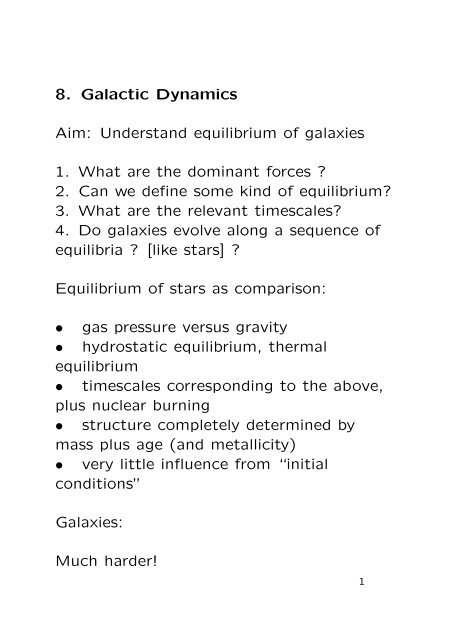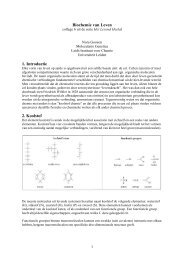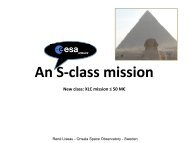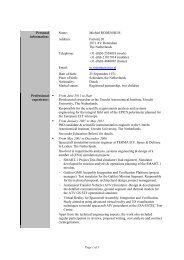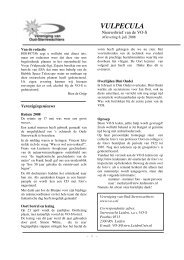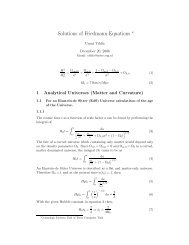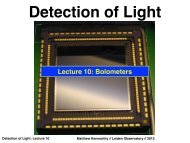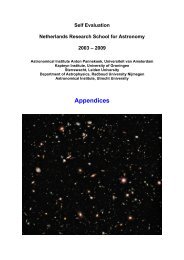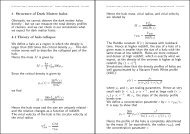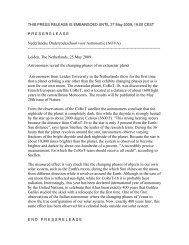8. Galactic Dynamics Aim: Understand equilibrium of galaxies 1 ...
8. Galactic Dynamics Aim: Understand equilibrium of galaxies 1 ...
8. Galactic Dynamics Aim: Understand equilibrium of galaxies 1 ...
Create successful ePaper yourself
Turn your PDF publications into a flip-book with our unique Google optimized e-Paper software.
<strong>8.</strong> <strong>Galactic</strong> <strong>Dynamics</strong><br />
<strong>Aim</strong>: <strong>Understand</strong> <strong>equilibrium</strong> <strong>of</strong> <strong>galaxies</strong><br />
1. What are the dominant forces ?<br />
2. Can we define some kind <strong>of</strong> <strong>equilibrium</strong>?<br />
3. What are the relevant timescales?<br />
4. Do <strong>galaxies</strong> evolve along a sequence <strong>of</strong><br />
equilibria ? [like stars] ?<br />
Equilibrium <strong>of</strong> stars as comparison:<br />
• gas pressure versus gravity<br />
• hydrostatic <strong>equilibrium</strong>, thermal<br />
<strong>equilibrium</strong><br />
• timescales corresponding to the above,<br />
plus nuclear burning<br />
• structure completely determined by<br />
mass plus age (and metallicity)<br />
• very little influence from “initial<br />
conditions”<br />
Galaxies:<br />
Much harder!<br />
1
Galaxy dynamics: assume ensemble <strong>of</strong> point<br />
masses, moving under influence <strong>of</strong> their own<br />
gravity<br />
Point masses can be: stars, mini BHs,<br />
planets, very light elementary particles ...<br />
Overview<br />
<strong>8.</strong>1 What are the equations <strong>of</strong> motion ?<br />
<strong>8.</strong>2 Do stars collide ? (BT p. 3+4)<br />
<strong>8.</strong>3 Virial Theorem<br />
<strong>8.</strong>4 Application: Galaxy masses (BT p.<br />
211-214)<br />
<strong>8.</strong>5 Binding Energy and Formation <strong>of</strong><br />
Galaxies (BT p. 214)<br />
<strong>8.</strong>6 Scaling Relations<br />
<strong>8.</strong>7 Relevant Time scales (BT p. 187-190)<br />
(Dynamical timescale, particle interaction<br />
timescale, Relaxation time for large<br />
systems)<br />
2
<strong>8.</strong>1 Equations <strong>of</strong> motion<br />
Assume a collection <strong>of</strong> masses mi at<br />
location xi, and assume gravitational<br />
interaction. Hence the force � Fi on particle i<br />
is given by:<br />
d 2<br />
�Fi = mi<br />
dt2�xi = �<br />
j�=i<br />
�xj − �xi<br />
|�xj − �xi| 3Gmimj<br />
• Only analytic solution for 2 point masses<br />
• “Easy” to solve numerically (brute<br />
force) - but slow for 10 11 particles. See for<br />
example:<br />
• Analytic approximations necessary for a<br />
better understanding <strong>of</strong> solution<br />
In the following we investigate properties <strong>of</strong><br />
gravitational systems without explicitly<br />
solving the equations <strong>of</strong> motion.<br />
3
<strong>8.</strong>2 Do stars collide?<br />
Is it safe to ignore non-gravitational<br />
interactions ?<br />
Example: our galaxy<br />
10 11 stars with a total mass <strong>of</strong> 5 × 10 10 M⊙<br />
A disk <strong>of</strong> 20 kpc in size, and thickness <strong>of</strong> 1<br />
kpc<br />
The sun is 8 kpc from the center<br />
Cross section <strong>of</strong> the sun σ = π ∗ (2R⊙) 2<br />
with R⊙ = 7 × 10 10 cm<br />
Typical orbital speed 200 km/s.<br />
1 km/s ∼ 1 pc in 1 Myr.<br />
One orbit: 250 Myr.<br />
Age <strong>of</strong> the galaxy: 10 1 0 yr<br />
Sun has made 30 revolutions and disk is in<br />
quasi steady state<br />
4
Calculate number <strong>of</strong> collisions between t1<br />
and t1 + dt <strong>of</strong> stars coming in from the left,<br />
in a galaxy with homogeneous number<br />
density n.<br />
• incoming star has velocity v<br />
• suppose all stars have radius r∗<br />
• incoming star will collide with stars in<br />
cylinder with volume V1:<br />
−> V1 = π(2r∗) 2 × v × dt<br />
• number <strong>of</strong> stars in V1 : N1 = nV1<br />
• number <strong>of</strong> collisions per unit time:<br />
N1<br />
dt<br />
= nV1<br />
dt = 4πr2 ∗ nv<br />
5
This gives a collision rate <strong>of</strong> 1.6×10 −26<br />
sec −1 = 5×10 −19 yr −1 .<br />
Note that the age <strong>of</strong> the Universe is<br />
13.75 ± 0.11 Gyr ∗<br />
So collisions are very rare indeed. Hence we<br />
can ignore these collisions without too<br />
much trouble.<br />
∗ Komatsu, E., et.al.,<br />
http://arXiv.org/abs/1001.4538<br />
6
<strong>8.</strong>3 Virial Theorem:<br />
Relation for global properties:<br />
Kinetic energy and Potential energy.<br />
Again consider our system <strong>of</strong> point masses<br />
mi with positions �xi.<br />
Construct �<br />
i �pi�xi and differentiate w.r.t.<br />
time:<br />
d<br />
dt<br />
�<br />
i<br />
�pi�xi = d<br />
dt<br />
where I = �<br />
inertia.<br />
�<br />
i<br />
i mix 2 i<br />
d�xi<br />
mi<br />
dt �xi = d<br />
dt<br />
= 1d<br />
2<br />
2I dt2 �<br />
i<br />
1<br />
2<br />
d<br />
dt (mix 2 i )<br />
, which is the moment <strong>of</strong><br />
However, using the chain rule, we can also<br />
write:<br />
d<br />
dt<br />
�<br />
i<br />
�pi�xi = �<br />
i<br />
d�pi<br />
dt �xi + �<br />
i<br />
d�xi<br />
�pi<br />
dt<br />
7
Then<br />
�<br />
i<br />
d�xi<br />
�pi<br />
dt<br />
= �<br />
i<br />
mi�v 2 i<br />
with K the kinetic energy.<br />
Since d�pi<br />
dt = � Fi we have<br />
1d2I<br />
2 dt<br />
2 = �<br />
i<br />
= 2K<br />
�Fi�xi + 2K.<br />
Now assume the galaxy is ’quasi-static’, i.e.<br />
its properties change only slowly so that<br />
d2I dt2 = 0. Then the equation above implies<br />
.<br />
K = − 1<br />
2<br />
�<br />
i<br />
�Fi�xi<br />
8
Then assume that the force � Fi can be<br />
written as a summation over ’pairwise<br />
forces’ � Fij<br />
Now realize that<br />
�<br />
i<br />
�Fi = �<br />
j,j�=i<br />
�Fi�xi = �<br />
i<br />
�Fij<br />
�<br />
j�=i<br />
�Fij�xi<br />
This summation can be rewritten. We sum<br />
the terms over the full area 0 < i ≤ N,<br />
0 < j ≤ N, i �= j. However, we can also limit<br />
the summation over just half this area:<br />
0 < i ≤ N, i < j ≤ N, and add the (j, i) term<br />
explicitly to the (i, j) term within the<br />
summation.<br />
9
Hence instead <strong>of</strong> summing over � Fij�xi, we<br />
sum over � Fij�xi + � Fji�xj<br />
Hence<br />
�<br />
i<br />
�<br />
j�=i<br />
�Fij�xi = �<br />
i<br />
�<br />
j>i<br />
( � Fij�xi + � Fji�xj)<br />
This is simply a change in how the<br />
summation is done, it does not use any<br />
special property <strong>of</strong> the force field.<br />
Because � Fij = − � Fji (forces are equal and<br />
opposite for pairwise forces) the last term<br />
can be rewritten<br />
�<br />
i<br />
�Fi�xi = �<br />
i<br />
�<br />
j>i<br />
�Fij(�xi − �xj)<br />
For gravitational force � Fij = − Gmimj<br />
|�xi−�xj| 2<br />
�xi−�xj<br />
|�xi−�xj|<br />
10
�<br />
i<br />
�Fi�xi = − �<br />
which equals<br />
= − �<br />
i<br />
�<br />
j>i<br />
i<br />
�<br />
j>i<br />
Gmimj<br />
|�xi − �xj|<br />
Gmimj<br />
|�xi − �xj| 3(�xi − �xj)(�xi − �xj)<br />
= −1<br />
2<br />
�<br />
i<br />
�<br />
j�=i<br />
Gmimj<br />
|�xi − �xj|<br />
with W the total potential energy.<br />
Therefore for a galaxy in quasi-static<br />
<strong>equilibrium</strong>:<br />
K = − 1<br />
2 W,<br />
= W<br />
eq.(1)<br />
which is the virial theorem for quasi-static<br />
systems. The more general expression for<br />
non-static systems is:<br />
1d<br />
2<br />
2I = W + 2K.<br />
dt2 11
<strong>8.</strong>4 Application: Galaxy masses<br />
Consider a system with total mass M<br />
Kinetic energy K = 1 2 M〈v2 〉 with<br />
〈v 2 〉 = mean square speed <strong>of</strong> stars<br />
(assumption: speed <strong>of</strong> star not correlated<br />
with mass <strong>of</strong> star)<br />
Define gravitational radius rg<br />
GM 2<br />
W = −<br />
rg<br />
Spitzer found for many systems that<br />
rg = 2.5r h, where r h is the radius which<br />
contains half the mass<br />
Virial theorem implies:<br />
M〈v 2 〉 =<br />
GM 2<br />
rg<br />
12
or<br />
M = 〈v 2 〉rgG −1<br />
Hence, we can estimate the mass <strong>of</strong><br />
<strong>galaxies</strong> if we know the typical velocities in<br />
the galaxy, and its size!<br />
13
<strong>8.</strong>5 Binding Energy and Formation <strong>of</strong><br />
Galaxies<br />
The total energy E <strong>of</strong> a galaxy is<br />
E = K + W = −K = 1/2W<br />
• Bound <strong>galaxies</strong> have negative energy -<br />
cannot fall apart and dissolve into a very<br />
large homogeneous distribution<br />
• A galaxy cannot just form from an<br />
unbound, extended smooth distribution −><br />
E total = Estart ≈ 0, E gal = −K, so energy<br />
must be lost or the structure keeps<br />
oscillating:<br />
Possible energy losses through<br />
• Ejection <strong>of</strong> stars<br />
• Radiation (before stars would form)<br />
14
<strong>8.</strong>6. Scaling Relations<br />
Consider a steady state galaxy with<br />
particles mi at location xi(t).<br />
Can the galaxy be rescaled to other physical<br />
<strong>galaxies</strong>?<br />
• scaled particle mass ˆmi = ammi<br />
• scaled particle location ˆxi = axxi(att)<br />
• am, ax, at are scaling parameters<br />
In the ’rescaled’ galaxy we have<br />
ˆ�Fi = ammi d2<br />
dt 2ax�x(att) = amaxa 2 t � F i,orig<br />
The gravitational force is equal to<br />
ˆ�F G = �<br />
j�=i<br />
a 2 m<br />
a 2 x<br />
�F G,orig<br />
ax�xj−ax�xi<br />
|ax�xj−ax�xi| 3Gammiammj =<br />
15
Equilibrium is satisfied if the two terms<br />
above are equal<br />
ˆ�Fi = ˆ� FG<br />
Since we have <strong>equilibrium</strong> when all scaling<br />
parameters are equal to 1, we obtain<br />
or<br />
amaxa 2 t = a2m a2 ,<br />
x<br />
am = a 3 xa 2 t .<br />
Now how do velocities scale ?<br />
ˆv = d d<br />
ˆx =<br />
dt dt axx(att) = axatvorig Hence, the scaling <strong>of</strong> the velocities satisfies:<br />
av = ax at. We can write the new scaling<br />
relation as<br />
am = axa 2 v<br />
Hence ANY galaxy can be scaled up like<br />
this!<br />
16
Notice that it is trivial to derive this from<br />
the virial theorem - the expression for the<br />
mass has exactly the same form.<br />
As a consequence, if we have a model for a<br />
galaxy with a certain mass and size, we can<br />
make many more models, with arbitrary<br />
mass, and arbitrary size.<br />
17
<strong>8.</strong>7 Time scales<br />
Dynamical timescale,<br />
particle interaction timescale<br />
Is gravitational force dominated by short or<br />
long range encounters? (N.B. in a gas, only<br />
short range forces are relevant).<br />
In a galaxy, the situation is different.<br />
Consider force with which stars in cone<br />
attract star in apex <strong>of</strong> cone.<br />
18
Force ∼ 1/r 2 , with r the distance from<br />
apex. If ρ is almost constant, then the mass<br />
in a shell with width dr increases as r 2 dr.<br />
Hence differential force is constant at each<br />
r, and we have to integrate all the way out<br />
to obtain the total force.<br />
Realistic densities decrease after some<br />
radius, so that the force will be determined<br />
by the density distribution on a galactic<br />
scale (characterized by the half mass<br />
radius).<br />
19
Relaxation time<br />
Short range encounters do not dominate →<br />
Approximate force field with a smooth<br />
density ρ(x) instead <strong>of</strong> point masses.<br />
• Contrary <strong>of</strong> situation in gas: only<br />
consider long range encounters (long range<br />
∼ scale <strong>of</strong> the galaxy)<br />
Assume all stars have mass m. Analyze<br />
perturbations due to the fact that density is<br />
not smooth, but consists <strong>of</strong> individual stars.<br />
Simplify, and look first at single star-star<br />
encounter.<br />
What is the amount δv induced by one star<br />
crossing another?<br />
Estimate: straight line trajectory past<br />
stationary perturber<br />
20
The perpendicular force � F ⊥ gives<br />
perturbation δ�v ⊥:<br />
�F ⊥ = Gm2 cos θ<br />
r 2<br />
=<br />
Newton: d<br />
dt δ�v ⊥ = � F⊥ m<br />
Gm<br />
bv<br />
δ�v ⊥ =<br />
∞�<br />
−∞<br />
�<br />
dt � F ⊥<br />
m =<br />
= Gm2cos θ<br />
(b2 +x2 ) =<br />
Gm2b (b2 +x2 ) 3/2<br />
Gm 2<br />
b 2 [1+(vt/b) 2 ] 3/2<br />
�<br />
ds<br />
(1 + s2 Gm<br />
=<br />
) 3/2 bv<br />
⇒<br />
Gm<br />
b 2 [1 + (vt/b) 2 ]<br />
s<br />
�<br />
1 + s 2|∞ −∞<br />
3/2dt =<br />
= 2Gm<br />
bv<br />
In words: δv is roughly equal to acceleration<br />
at closest approach, Gm/b 2 , times the<br />
duration 2b/v.<br />
21
Note: approximation fails when<br />
δ�v ⊥ > v ⇒ b < Gm/v 2 ≡ b min<br />
Galaxy has characteristic radius R.<br />
Define crossing time tc as the time it takes<br />
a star to move through the galaxy tc = R/v<br />
Calculate number <strong>of</strong> perturbing encounters<br />
per crossing time tc<br />
In a crossing time, the star has 1<br />
“encounter” with each other star in the<br />
galaxy<br />
The impact parameter <strong>of</strong> each encounter<br />
can be derived by projecting each star onto<br />
a plane perpendicular to the unperturbed<br />
motion <strong>of</strong> the star<br />
Hence “flatten” the galaxy in the plane<br />
perpendicular to the motion <strong>of</strong> the star, and<br />
22
assume that the stars are homogeneously<br />
distributed in that plane, out to a radius R,<br />
and no stars outside R. This is obviously a<br />
simplifying assumption, but it is reasonably<br />
accurate.<br />
This can be used to derive the distribution<br />
<strong>of</strong> impact parameters:<br />
N stars in total in Galaxy, distributed over<br />
total surface πR 2<br />
stellar surface density / # per unit area:<br />
N<br />
πR 2<br />
In a crossing time, the star has δn<br />
encounters with impact parameter between<br />
b and b + db. δn is given by the area <strong>of</strong> the<br />
annulus 2πbdb times the density <strong>of</strong> stars on<br />
the surface, which is N/(πR 2 ):<br />
δn = N<br />
πR22πbdb =<br />
2N<br />
R2 b db<br />
23
Result: � δv ⊥ = 0 as the perturbations are<br />
randomly distributed, and will not change<br />
the average velocity<br />
� δv 2 ⊥ = δv 2 δn =<br />
= 8N<br />
� �2 2Gm 2Nb<br />
db<br />
bv R2 � �2 Gm db<br />
Rv<br />
as each perturbation adds to � δv ⊥ by an<br />
equal amount (2Gm/bv) 2 .<br />
The encounters do not produce an average<br />
perpendicular velocity, but they do produce<br />
an average (perpendicular velocity) 2 .<br />
Hence, on average, the stars still follow<br />
their average path, but they tend to<br />
“diffuse” around it.<br />
b<br />
24
The total increase in rms perpendicular<br />
velocity can be calculated by integrating<br />
over all impact parameters from bmin to<br />
infinity:<br />
Total rms increase:<br />
∆v 2 =<br />
R<br />
�<br />
b min<br />
=8N( Gm<br />
Rv )2 ln Λ<br />
� δv 2 ⊥ db =<br />
R<br />
�<br />
b min<br />
8N<br />
� Gm<br />
Rv<br />
�2<br />
with ln Λ = Coulomb logarithm = ln R<br />
b min<br />
We can rewrite this equation. Recall:<br />
b min ≡ Gm/v 2<br />
From virial theorem:<br />
v 2 = GM/R = GNm/R<br />
db/b =<br />
25
Hence: bmin = Gm/(GNm/R) = R/N<br />
ln Λ = ln R/bmin = ln R<br />
R/N<br />
Furthermore from virial theorem:<br />
GM 2<br />
= ln N<br />
R = Mv2 → GM<br />
R = v2 → GNm<br />
R<br />
so that: 〈∆v2 ⊥ 〉<br />
v 2<br />
→ N = v2 R<br />
Gm<br />
=<br />
8 ln N<br />
N<br />
= v2<br />
This last number is the fractional change in<br />
energy per crossing time. Hence we need<br />
the inverse number <strong>of</strong> crossings N/(8 ln N)<br />
to get 〈∆v2 ⊥ 〉 ∼ v2<br />
26
The timescale t relax is defined as the time it<br />
takes to deflect each star significantly by<br />
two body encounters, and it is therefore<br />
equal to<br />
t relax = N<br />
8 ln N tc ≈ 0.1N<br />
ln N tc<br />
with crossing time: tc ≡ R/v<br />
27
Conclusions<br />
• effect <strong>of</strong> point mass perturbations<br />
decreases as N increases<br />
• even for low N=50, 〈∆v 2 ⊥ 〉/v2 = 0.6,<br />
hence deflections play a moderate role.<br />
• for larger systems the effect <strong>of</strong><br />
encounters become even less important<br />
Notice: one derives the same equation when<br />
the exact formulas for the encounters are<br />
used. Put in another way, the encounters<br />
with b < bmin do not dominate.<br />
28
Relaxation time for large systems<br />
System N tc (yr) t relax (yr)<br />
globular cluster 10 5 10 5 2 × 10 8<br />
galaxy 10 11 10 8 10 17<br />
galaxy cluster 10 3 10 9 3 × 10 10<br />
Age <strong>of</strong> Universe 13.7 Gyr.<br />
⇒ Galaxies are collisionless systems<br />
• motion <strong>of</strong> a star accurately described by<br />
single particle orbit in smooth gravitational<br />
field <strong>of</strong> galaxy<br />
• no need to solve N-body problem with<br />
N = 10 11 (!)<br />
29
Some more typical questions that can be<br />
asked at exam: (not homework<br />
assignments)<br />
• What is the virial theorem ?<br />
• How can we use it to scale <strong>galaxies</strong> ?<br />
• Do <strong>galaxies</strong> have a main sequence like<br />
stars ?<br />
• How is relaxation time defined ? What<br />
is the approximate expression ? What is the<br />
typical relaxation time for a galaxy ? How<br />
does the long relaxation time make it easier<br />
to produce models for <strong>galaxies</strong> ?<br />
30
<strong>8.</strong> Homework Assignments:<br />
1) How empty are <strong>galaxies</strong> ? Calculate the<br />
mean distance between stars. Take the<br />
radius <strong>of</strong> the sun as typical radius for a star.<br />
Take the ratio <strong>of</strong> the two. Compare this to<br />
the same ratio <strong>of</strong> <strong>galaxies</strong>: take the average<br />
distance between <strong>galaxies</strong>, and the radius <strong>of</strong><br />
<strong>galaxies</strong>.<br />
2) calculate the mass <strong>of</strong> our galaxy for two<br />
assumed radii:<br />
a.) 10 kpc (roughly the distance to the sun)<br />
b.) 350 kpc (halfway out to Andromeda)<br />
Take as a typical velocity the solar value <strong>of</strong><br />
200 km/s.<br />
3) Show explicitly that the virial theorem<br />
produces the same result for the scaling<br />
relations.<br />
4) Take typical sizes, velocities, number <strong>of</strong><br />
stars for globular clusters, <strong>galaxies</strong>, and<br />
31
galaxy clusters. Calculate for each <strong>of</strong> the<br />
systems, the average time between stellar<br />
collisions, crossing times and relaxation<br />
times.


